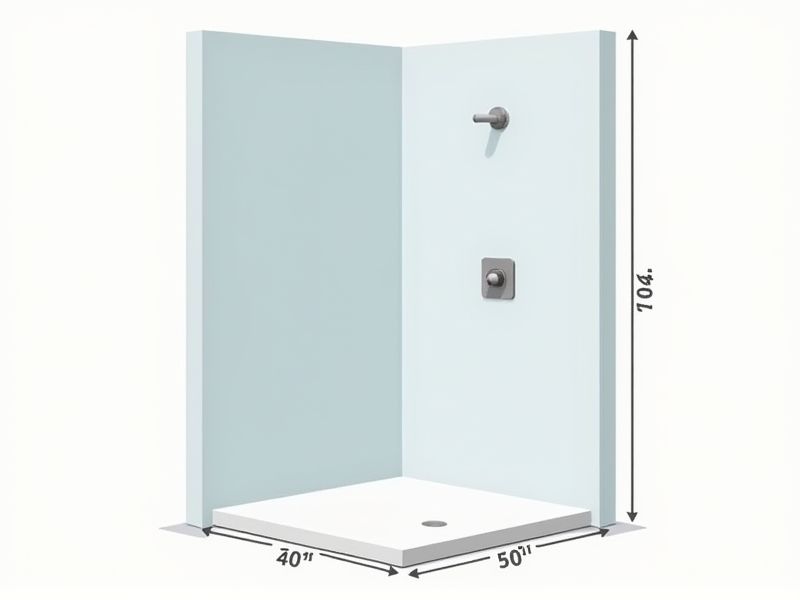
The standard dimensions of a shower stall are typically 36 inches by 36 inches, which provides enough space for most people to shower comfortably. If you're working with a smaller bathroom, you might find compact stalls starting at around 32 inches by 32 inches, while larger, more luxurious options can measure up to 48 inches by 36 inches or even more. It's important to check local building codes and consider the accessibility needs of those using the shower when choosing dimensions. By selecting the right size, you can maximize comfort and functionality in your bathroom layout.
Width And Depth Variations
A standard shower stall commonly measures 36 inches in width and 36 inches in depth, providing enough space for comfortable movement. However, larger models can reach up to 42 inches in width and 48 inches in depth, accommodating those who prefer extra room. For compact bathrooms, a corner shower stall may offer dimensions as narrow as 30 inches, optimizing space without sacrificing functionality. When selecting a shower stall, consider your specific needs for both width and depth to ensure an efficient and enjoyable bathing experience.
Height Requirements
The standard height requirement for a shower stall typically ranges from 72 to 78 inches, ensuring adequate space for most users. In some instances, a height of 80 inches may be necessary to accommodate taller individuals and prevent water splashing. Your local building codes may dictate specific minimum heights, so it's essential to verify regulations in your area. Installing a height-appropriate shower stall not only enhances comfort but also promotes accessibility for individuals of varying heights.
Door Opening Clearance
A standard shower stall typically requires a door opening clearance of at least 22 inches to ensure comfortable access and egress. This dimension helps accommodate various user needs, including individuals with mobility challenges. To enhance usability, the height of the door should ideally extend from floor to a minimum of 72 inches, preventing water from splashing outside while providing an open feel. Ensuring these measurements meets building codes not only improves safety but also adds to the overall functionality of your bathroom space.
Entryway Width
The standard entryway width for a shower stall typically ranges from 22 to 30 inches, ensuring accessibility and comfort during entry and exit. This width allows for easy maneuverability while maintaining a spacious feel within the bathroom. For optimal design, consider that wet areas should feature non-slip surfaces, which enhances safety, especially in smaller stalls. Properly accommodating these dimensions can significantly improve the overall functionality and user experience of your shower space.
Drain Positioning
Proper drain positioning is crucial for an effective shower stall design, ensuring optimal water flow and preventing pooling. For a standard shower stall, the drain should ideally be located at the lowest point of the floor, typically within 3 to 6 inches from the wall edges, allowing for a gradual slope of at least 1% to 2%. This slope facilitates drainage, minimizes water retention, and enhances hygiene by reducing mold and mildew growth. You should consider a central drain placement in larger stalls for equal water distribution, while smaller stalls may benefit from a linear drain for a sleek, modern aesthetic.
Installation Space
A standard shower stall typically requires a minimum installation space of 30 inches by 30 inches, with a preferable size of 36 inches by 36 inches for added comfort. The height should generally extend from 72 inches to 78 inches to accommodate various user heights while ensuring enough headroom. Proper drainage needs a slope of 1/4 inch per foot towards the drain to prevent water pooling. When planning your bathroom layout, consider local building codes and accessibility requirements to ensure optimal usage and safety.
Material Thickness
When selecting a shower stall, material thickness is a crucial factor that affects durability and insulation. Typically, high-quality acrylic or fiberglass shower stalls have a thickness of at least 3/8 inch, ensuring resistance to cracking and fading. For tile options, a standard thickness of 1/4 inch for the backer board provides a sturdy foundation while maintaining waterproofing. Consider how these materials interact with your bathroom's overall design, as a well-chosen shower stall can enhance both aesthetics and functionality.
Accessibility Compliance
Shower stalls designed for accessibility compliance must adhere to the ADA (Americans with Disabilities Act) guidelines, ensuring a minimum of 60 inches by 30 inches of usable space. The entrance should have a threshold no higher than 1/2 inch to prevent tripping hazards, with grab bars installed at a height between 33 to 36 inches from the floor. Non-slip flooring is essential, decreasing the risk of falls, while handheld shower heads with a hose length of at least 60 inches offer flexibility for users. Lever-operated faucets should be easy to operate with one hand, accommodating individuals with limited dexterity.
Grout Line Spacing
Proper grout line spacing in shower stalls typically ranges from 1/16 inch to 1/8 inch, allowing for movement and preventing cracking. When installing tiles, maintaining consistent grout line widths is essential for aesthetic appeal and overall structural integrity. A wider grout line, up to 1/4 inch, may be necessary for larger tiles to accommodate variations in size. Regular maintenance, including cleaning and resealing grout every 6 to 12 months, can significantly extend the life of your shower stall's appearance and functionality.
Corner Versus Alcove Designs
Corner shower stalls typically maximize space in smaller bathrooms, utilizing two walls and providing an efficient, compact option; they often measure around 36 inches by 36 inches. Alcove designs, on the other hand, require three walls but can create a more spacious feel, frequently accommodating larger dimensions, such as 60 inches by 30 inches. Both designs can be customized with various materials and fixtures, giving you flexibility in aesthetics and functionality. It's essential to consider your bathroom layout and personal needs to choose the most suitable shower stall design.
